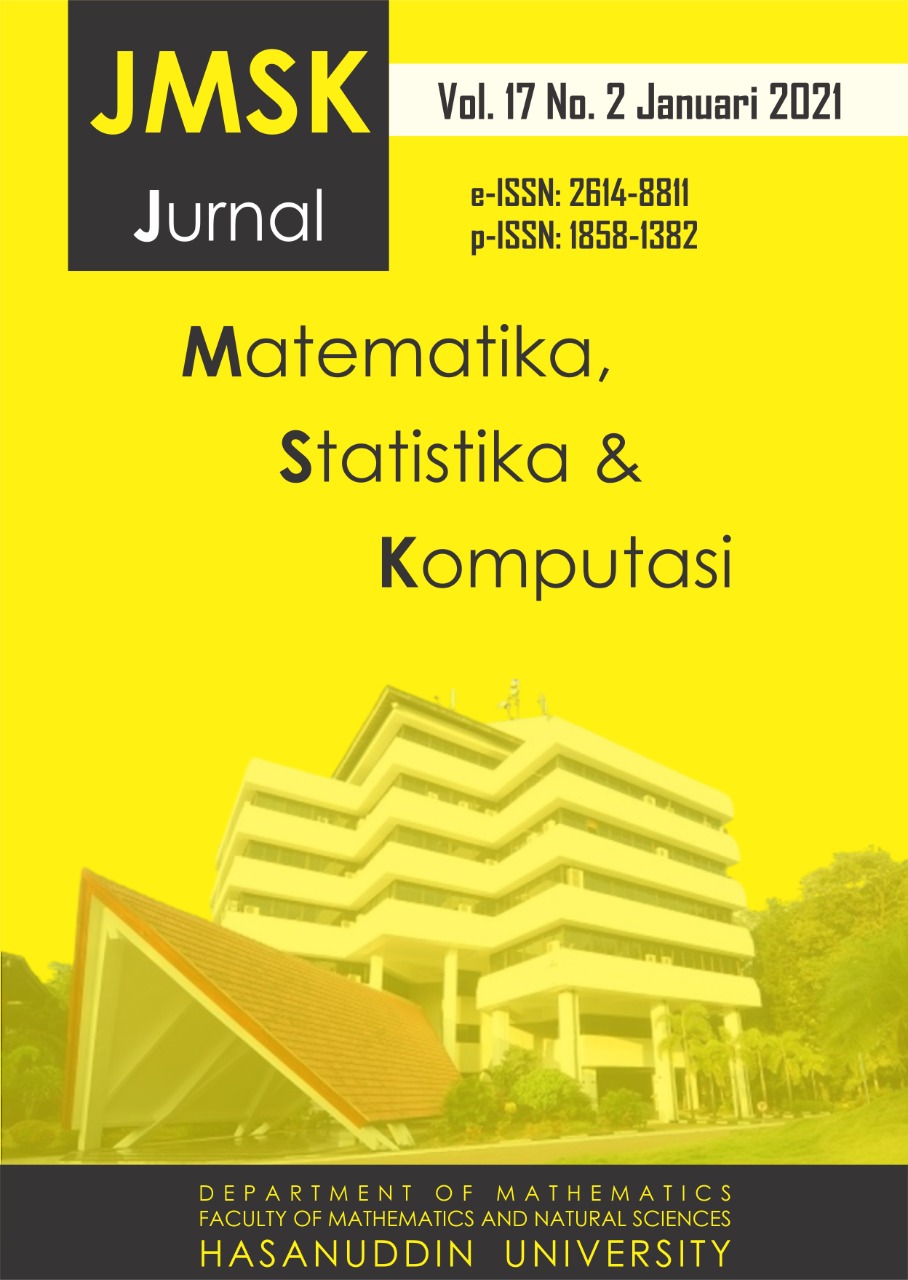Target prediction of compounds on jamu formula using nearest profile method
DOI:
https://doi.org/10.20956/jmsk.v17i2.11616Keywords:
supervised-learning, nearest profile, jamu, compund-target proteinAbstract
Jamu is one of Indonesia's cultural heritage, which consists of several plants that have been practiced for centuries in Indonesian society to maintain health and treat diseases. One of the scientification efforts of Jamu to reveal its mechanism is to predict the target-protein of the active ingredients of the Jamu. In this study, the prediction of the target compound for Jamu was carried out using a supervised learning approach involving conventional medicinal compounds as training data. The method used in this study is the closest profile method adopted from the nearest neighbor algorithm. This method is implemented in drug compound data to construct a learning model. The AUC value for measuring performance of the three implemented models is 0.62 for the fixed compound model, 0.78 for the fixed target model, and 0.83 for the mixed model. The fixed compound model is then used to construct a prediction model on the herbal medicine data with an optimal threshold value of 0.91. The model produced 10 potential compounds in the herbal formula and its 44 unique protein targets. Even though it has many limitations in obtaining a good performance, the closest profile method can be used to predict the target of the herbal compound whose target is not yet known.
References
Afendi, F. M., Heryanto, R., Darusman, L. K., Syahrir, N. H. A., Bakri, R., & Qomariasih, N, 2016. Jamu informatics: A new perspective in jamu research. CICSJ Bulletin, Vol. 34, No. 2, 47.
Afendi, F. M., Okada, T., Yamazaki, M., Hirai-Morita, A., Nakamura, Y., Nakamura, K., Ikeda, S., Takahashi, H., Altaf-Ul-Amin, M., Darusman, L. K., Saito, K., & Kanaya, S., 2012. KNApSAcK family databases: Integrated metabolite-plant species databases for multifaceted plant research. Plant and Cell Physiology, Vol. 53, No. 2, 1–12. https://doi.org/10.1093/pcp/pcr165
Bajusz, D., Rácz, A., & Héberger, K., 2015. Why is Tanimoto index an appropriate choice for fingerprint-based similarity calculations? Journal of Cheminformatics, Vol. 7, No. 1, 1–13. https://doi.org/10.1186/s13321-015-0069-3
Bleakley, K., & Yamanishi, Y., 2009. Supervised prediction of drug-target interactions using bipartite local models. Bioinformatics, Vol. 25, No. 18, 2397–2403. https://doi.org/10.1093/bioinformatics/btp433
Elfahmi, Woerdenbag, H. J., & Kayser, O., 2014. Jamu: Indonesian traditional herbal medicine towards rational phytopharmacological use. Journal of Herbal Medicine, Vol. 4, No. 2, 51–73. https://doi.org/10.1016/j.hermed.2014.01.002
Florkowski, C. M., 2008. Sensitivity, specificity, receiver-operating characteristic (ROC) curves and likelihood ratios: communicating the performance of diagnostic tests. The Clinical Biochemist. Reviews, 29 Suppl 1(Suppl 1), S83–S87. https://www.ncbi.nlm.nih.gov/pubmed/18852864
Fukunishi, Y., & Nakamura, H., 2011. Prediction of ligand-binding sites of proteins by molecular docking calculation for a random ligand library. Protein Science, Vol. 20, No.1, 95–106. https://doi.org/10.1002/pro.540
Liu, Y., Hong, Y., Lin, C. Y., & Hung, C. L., 2015. Accelerating Smith-Waterman Alignment for Protein Database Search Using Frequency Distance Filtration Scheme Based on CPU-GPU Collaborative System. International Journal of Genomics, 2015. https://doi.org/10.1155/2015/761063
Tung, C.-W., 2015. Public Databases of Plant Natural Products for Computational Drug Discovery. Current Computer Aided-Drug Design, Vol. 10, No. 3, 191–196. https://doi.org/10.2174/1573409910666140414145934
Wang, Y., Bryant, S. H., Cheng, T., Wang, J., Gindulyte, A., Shoemaker, B. A., Thiessen, P. A., He, S., & Zhang, J., 2017. PubChem BioAssay: 2017 update. Nucleic Acids Research, Vol. 45, No. D1, D955–D963. https://doi.org/10.1093/nar/gkw1118
Wishart, D. S., Feunang, Y. D., Guo, A. C., Lo, E. J., Marcu, A., Grant, J. R., Sajed, T., Johnson, D., Li, C., Sayeeda, Z., Assempour, N., Iynkkaran, I., Liu, Y., MacIejewski, A., Gale, N., Wilson, A., Chin, L., Cummings, R., Le, Di., … Wilson, M., 2018. DrugBank 5.0: A major update to the DrugBank database for 2018. Nucleic Acids Research, Vol. 46, No. D1, D1074–D1082. https://doi.org/10.1093/nar/gkx1037
Wu, Z., Li, W., Liu, G., & Tang, Y., 2018. Network-based methods for prediction of drug-target interactions. Frontiers in Pharmacology, Vol.9, 1–14. https://doi.org/10.3389/fphar.2018.01134
Yamanishi, Y., Araki, M., Gutteridge, A., Honda, W., & Kanehisa, M., 2008. Prediction of drug-target interaction networks from the integration of chemical and genomic spaces. Bioinformatics, Vol. 24, No.23, 232–240. https://doi.org/10.1093/bioinformatics/btn162
Downloads
Published
How to Cite
Issue
Section
License
Copyright (c) 2020 Author and publisher

This work is licensed under a Creative Commons Attribution 4.0 International License.

This work is licensed under a Creative Commons Attribution 4.0 International License.
Jurnal Matematika, Statistika dan Komputasi is an Open Access journal, all articles are distributed under the terms of the Creative Commons Attribution License, allowing third parties to copy and redistribute the material in any medium or format, transform, and build upon the material, provided the original work is properly cited and states its license. This license allows authors and readers to use all articles, data sets, graphics and appendices in data mining applications, search engines, web sites, blogs and other platforms by providing appropriate reference.







